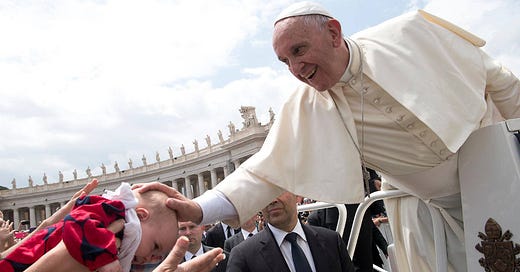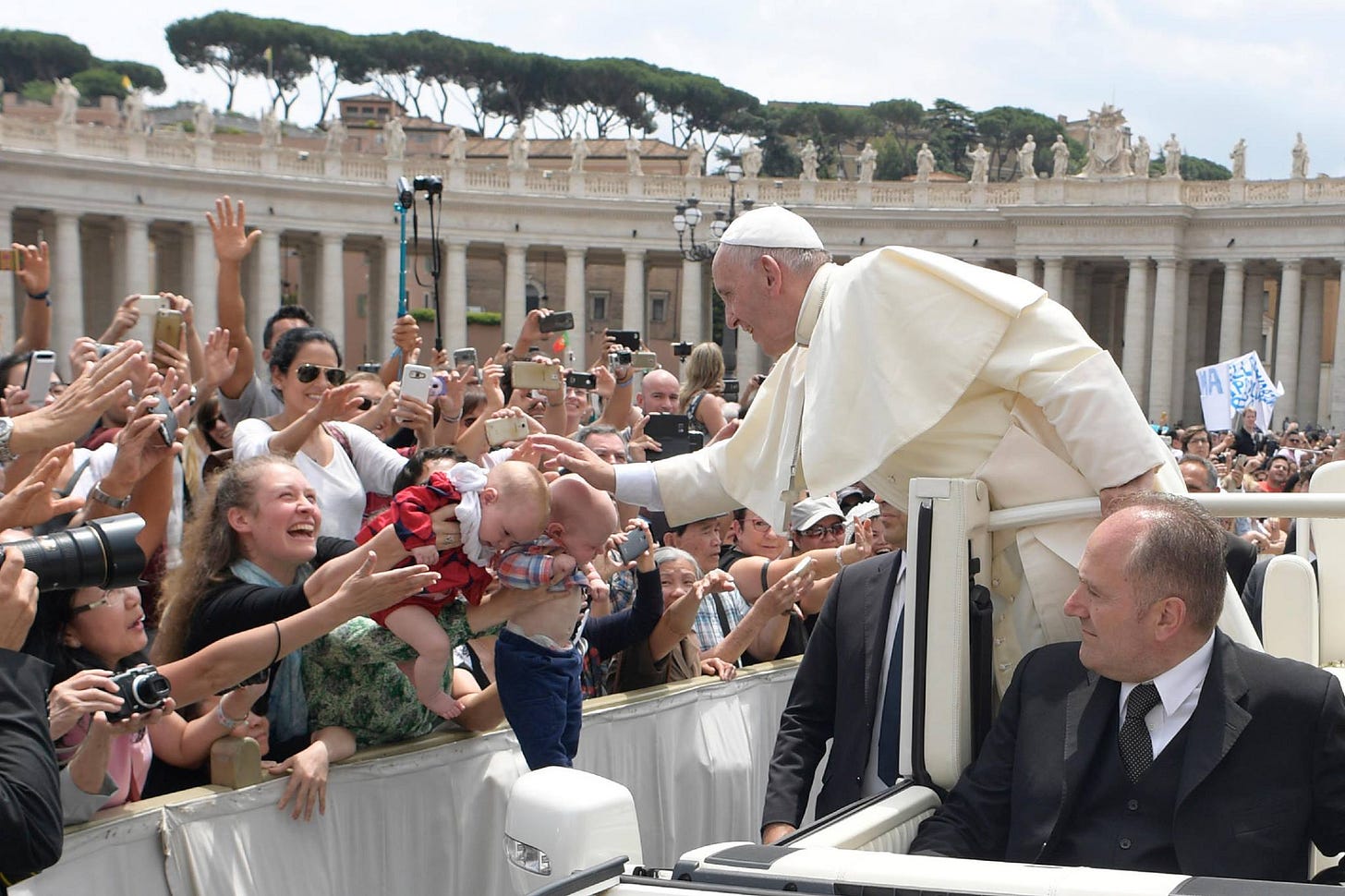The experience of Catholicism today does not resemble the descriptions of previous generations. Catholics used to describe the faith as immutable. Some celebrated the comfort of changelessness, the sense that here was something truly eternal; haters lamented the blockheaded institutional obstinacy. Now the experience is transience, not intransigence. Half the parishes are gone, the greatest transience of all. The rest swing like pendula between liberal and conservative. The parish my mom attended had a pastor who liked all the liberal trappings: ad-lib consecration, applause during Mass, goofball sermons with lots of laughs, the usual. Then came a conservative pastor who changed the whole style of the parish: strict use of the Roman canon, no female lectors, no altar girls, more statues of saints and more money spent on altar decorations. Then he left, and the liberal touches came back. The pattern repeats everywhere: a conservative pastor takes over a parish and fills it with icons; a liberal pastor comes in and sells the stuff to achieve a modern, streamlined look. One pastor spends good money to rip out the altar rail, the next pastor spends good money to put one in. One pastor brings in a Latin Mass, the next bans it. One turns to the altar, the other faces the people. If you are flexible, you accept that it all changes; if you are sentimental, you lament it; if your loyalty is to a particular theology or particular style, you find yourself a new parish.
With Benedict XVI, parochial bipolarism gained intensity. Benedict’s opening up the Traditional Latin Mass to general use in Summorum Pontificum did not obligate anyone to celebrate it, but it did empower individual pastors to come in and create “traddy” parishes out of liberal ones, regardless of what the parishioners thought. This was problem enough. Then came Pope Francis. Traditionis Custodes encouraged bishops to get in on the fun of jerking parishes and even whole dioceses from one extreme to another. The archdiocese of Detroit had until recently more TLMs than perhaps any diocese in the world. Then Pope Francis appointed a new bishop, and almost all were banned overnight.
This perpetual inhouse feuding is obviously injurious. Some people like the TLM. A wise bishop would use Latin as just another tool for evangelism, identifying good candidates for Latin Mass parishes the same way he would strategically locate Spanish or Polish parishes. Latin Mass parishes have a consistent track record, for instance, of restoring to life beautiful old churches in city centers now largely devoid of Catholic populations (such as Detroit). They could be used specifically to make something out of otherwise defunct parishes. The bishop would then try to let the parishes settle into some kind of identity. I remember when St. Agnes in Manhattan had a Latin Mass, or St. Mary’s in New Haven was run by Dominicans. These kind of traditions the current Catholic hierarchy seems bent on upending. It feels like continual loss.
Much of the drama for Catholics in the coming conclave comes from the fact that a large and powerful segment of the Catholic clergy hate this kind of practical approach to Church governance and liturgical diversity. They hate the Traditional Latin Mass, and in some instances would rather close a parish than allow a TLM there. For those of us who are more reasonable, the hostility is consistently surprising. Some people find spiritual satisfaction in, say, attending the Mozart Requiem Mass. This strikes me as something people might well get spiritual satisfaction from. It is one of the Catholic Church’s treasures. Why not use it?
A representative answer can be found in a recent article published in America magazine by Fr. John F. Baldovin, a Jesuit professor of Historical and Liturgical Theology at Boston College. Fr. Baldovin, in his “Where is God in the Liturgy? A Way Forward for Reform and Renewal,” admits that a “significant minority of Catholics” find the TLM “spiritually nourishing.” But he doesn’t care about them. He insists that “the pre-Vatican II liturgy should be definitely abrogated,” for reasons that are “theological rather than merely aesthetic.” “The post-Vatican II Eucharistic liturgy,” he writes, “embodies a significantly different understanding of the church than that embodied by the older rite.” This difference is not merely one of emphasis, but of real error – everything before Vatican II was bad theology. Hence the need for extermination.
This kind of Maoism in the Church, where all that is old needs to be definitively destroyed, has been a continual theme since Vatican II. Fr. Rembert Weakland, placed in charge of the Liturgical Music Commission for the United States after Vatican II, explained why chant, polyphony, sung Masses, and the old hymns had to be scrapped: “False liturgical orientation produced our liturgical music,” he declared, “and false liturgical orientation perpetuated it.” This is the judgement Baldovin and others apply to the entire documented history of the Church until their own arrival.
I will note that there are advantages to this sort of approach. It is liberating: you don’t need to be bound by yesterday. Taken to its fullest extent, each moment could be liberated from the oppression of the previous one. It allows the Church to break easily with past mistakes. It allows the Church to join the world of “liquid modernity,” where vows, rules, language, texts, meanings all shift as needed. Flexibility is paramount. Rules and doctrines can be replaced by a more generic sense of “belonging” and “accompaniment” – more like a family, where your membership is not dependent on your beliefs, or like the Anglican Church, which has shown tremendous theological flexibility in the past half century. Massimo Faggioli, a professor at Villanova, explained to the 2021 U.S. Conference of Bishops that the real meaning of Vatican II was “a shift from cognitive and propositional to a personalist and dialogical understanding of revelation.” “Cognitive and propositional” understandings were pre-Vatican II and bad.
I appreciate the liberation promised by such approaches. We would be able to do away with creeds, prayers, vows, laws, Scriptures, and suchlike, all of which are “cognitive” and “propositional,” and replace them with whatever we may want in the moment. A case could be made that this is the religion which is truly proper to modernity.
However, people who want such a religion are wise enough not to bother with the Catholic Church. They have better uses for their money than paying for Massimo Faggioli to give talks at bishops’ conferences. And so steps toward religious modernism never turn out to be popular. Why bother with religious modernism when you can just have modernism? The latest word out of England, for instance, is that there are more young Catholics there than young Anglicans. Anglican theological liquidity has emptied its churches of worshipers.
Besides being unpopular, a persistent turn away from the cognitive and propositional would mean the end of any kind of religion of the Logos, the Word of God. Baldovin and Faggioli are suggesting we have an entirely new religion founded in the 1960s, a Paulianity founded by Paul VI. Hence dynamiting all the remains of the old religion, to them, sounds like pious religious activity, like Muhammad taking hammer and fire to the idols of the Kaaba.
They’ve certainly done a great deal of damage so far, but almost everyone now agrees that the receding of the floodwaters is now not far away. The belief that everything before Vatican II is harmful and erroneous appears now mostly confined to people over the age of seventy. The problem is that the average age of the electors for the current conclave is 71. And popes are powerful. They can do a great deal of damage.
However, we the faithful have been dealing with the wreckovation for sixty years now. We are still here. We would like to have leaders whose joy is not in destruction. But we are not giving up. We are not here because we would like people with bishops’ hats to “accompany” us or “smell like the sheep.” We do not want to feel a stronger sense of participation or ownership of our Church. We are not interested in any Church that could be called ours. We are not interested in having a religion for our times. Our interest is being with Christ’s Church, and in Christ’s religion, extending all the way through the centuries to our own day. I have a picture of Pope Francis blessing my children, his hand on each of their heads. I am moved by the picture, but not because of Jorge Bergoglio himself. Anyone can go seek the right heroically alone. There are great heroes whose blessing I do not seek. In the end, it’s the tradition which gives the Church its stature. I am moved by the picture because a pope represents the tangible end of a chain that extends back to Christ himself. Christ made Peter a fisher of men; since that time all of us Christians have been drawn in by Peter’s dragnet. Everyone knows this; it is why Rome becomes the center of the world from the death of one pope to the installation of another. My children have been blessed by a man whose work began two thousand years ago at Christ’s side. That connection is what makes a pope a pope; and honoring each link of that chain stretching back through time is how a pope gains in stature. It is what I hope for from all my future popes.







Jesus said, “If the salt loses its flavor, it is good for nothing but to be thrown out and trampled underfoot” (Matt. 5:13). The Church’s theology is its salt—its very lifeblood. When we dilute it to suit modern tastes, we don’t gain relevance; we lose our purpose. Perhaps that’s why, despite everything, there are now more young Catholics than Anglicans in England. Salt still draws life.